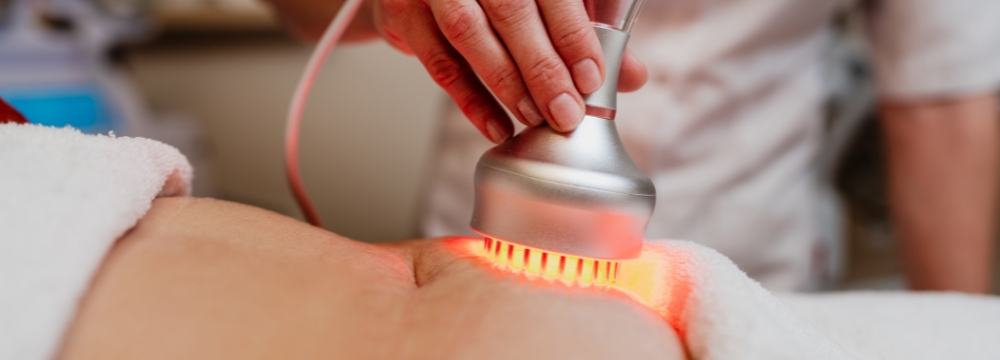Aesthetic Services
Infrared light therapy is gaining attention for its potential benefits in reducing fat, tightening skin, and managing inflammation. Here’s a breakdown of what the science says and how it might fit into your bariatric surgery recovery. (FYI, infrared light therapy is often referred to as low-level laser therapy (LLLT) or photobiomodulation, as both involve the use of low-power lasers or light-emitting diodes.)
How It Works
Infrared light comes in two flavors: near-infrared (NIR), which utilizes shorter wavelengths to enhance skin health, collagen production, and wound healing, and far-infrared (FIR), which employs longer wavelengths that penetrate deeper into muscles and tissues, helping to reduce inflammation and aid detoxification.
The two-pronged action of tightening skin via NIR while calming inflammation with FIR makes infrared therapy a compelling option for post-surgery care. But does it really work?
Fat Reduction and Body Contouring
Researchers have been exploring exactly that. The results so far are promising, but don’t think you can trade out good habits for fat-burning lights.
A 2020 pilot study demonstrated that low-level laser therapy can help reduce fat and improve blood lipid levels with minimal side effects. While researchers are still working out the mechanism behind how it works, this study proposes that it functions by creating tiny, temporary holes in fat cells, allowing them to leak out. It may also help some fat cells die off naturally, which can aid in shrinking fat layers.1
Clinical trials have also yielded promising results: individuals who received 12 low-level laser treatments twice a week over a six-week period experienced reductions in body weight, body fat, and body mass index (BMI). About 30% of participants in the twice-weekly group lost more than 3% of their starting weight. They also reported feeling better about their bodies and quality of life.2
Another small study examined the effects of a combination of red, near-infrared, and blue light applied to various parts of the abdomen. After 12 sessions, participants showed significant reductions in upper, middle, and lower abdominal measurements with no reported side effects. Participants saw measurable improvements, making it a promising tool for targeting stubborn fat areas.3
What isn’t exactly clear in these studies is the effect of simultaneous diet and exercise. While some research shows promising results, don’t be in a rush to jump to any conclusions. For now, infrared therapy isn’t a silver bullet. But it’s safe to say that when paired with healthy habits, it can potentially enhance fat loss and body contouring. Which brings us to the next study.
Boosting Exercise and Metabolism
Infrared treatments work best when used in conjunction with physical activity. (Aha, there it is!) Evidence suggests that combining low-level laser therapy (LLLT) with exercise not only reduces fat but also enhances metabolic functions. This was a small study, but here are the details:
In a 20-week clinical trial, 64 obese women were split into two groups. Both groups did the same mix of cardio and resistance training, but one group received infrared therapy after each workout. That group lost more fat (over 24 lbs on average), gained more muscle, and showed better improvements in insulin resistance and adiponectin (a hormone linked to fat metabolism) compared to those who only exercised.4
That makes sense: infrared light may help release fat, but your body still needs to burn it through activity or a calorie deficit. So while infrared can support fat loss, it’s most effective as part of a complete wellness plan.
Skin Tightening and Collagen Support
Near-infrared light also appears to play a role in skin tightening by stimulating fibroblasts, cells in the skin that help build collagen and elastin, both of which keep skin firm and elastic. In a lab-based study, red and near-infrared light treatments were shown to boost collagen and elastin production while increasing ATP, a type of energy used by cells to repair and grow. Researchers observed increases in specific genes and proteins associated with skin strength and elasticity, suggesting that this type of light therapy may help alleviate sagging or aging skin.5
In a separate study using actual patients, rather than lab models, near-infrared therapy was shown to significantly reduce facial volume and tighten skin, as measured using 3D imaging. After several treatments, patients experienced noticeable lifting effects with no serious side effects. Most reported they were satisfied with the improvement in skin laxity and facial lines.6
These mechanisms may be especially beneficial for bariatric patients seeking non-invasive support with loose skin, particularly when used in conjunction with strength training and a balanced diet. Again, tread lightly. These are small studies and must be considered preliminary results.
Inflammation and Recovery
Far-infrared light has also been researched for its anti-inflammatory properties. One study in rats with arthritis used FIR and found it lowered levels of specific inflammatory chemicals that the body produces. What does that mean for bariatric surgery patients? After surgery, those same chemicals can be present. Because this study demonstrated the influence of FIR on inflammation, it may offer a gentle, natural way to support recovery by aiding tissue repair after surgery.7
Another study, more directly related to bariatric patients, examined the effects of far-infrared light on stem cells. It found that FIR can slow down the formation of new fat cells and help create more bone cells instead. This occurs because the FIR changes signals within the cells. The authors of this study acknowledge that further research is needed in humans, but initial findings suggest that FIR could support recovery by helping the body build stronger, healthier tissue after bariatric surgery.8
While these findings are promising, it’s important to understand the safety and practicality of infrared light therapy when incorporated into post-surgical care.
Safety and Practical Considerations
Infrared light therapy appears to be generally safe when administered correctly. Most studies using low-level laser therapy report mild and infrequent side effects, particularly when treatment is administered according to professional guidelines and manufacturer protocols. Infrared light therapy is a non-invasive treatment that typically feels warm, soothing, or barely noticeable during use.
Studies haven’t pinpointed the perfect timeline for infrared use after bariatric surgery, but general advice is to wait until surgical wounds are fully healed. Infrared can then be safely added to your post-op routine to help with skin and inflammation, but check with your care team for timing that fits your specific healing process.
If you insist on looking into at-home devices, know that they aren’t created equal, varying widely in strength, wavelength, and construction. Using a poorly made or overly strong device could increase the risk of skin irritation, burns, or inconsistent results. It’s a good idea to speak with a qualified provider, especially one familiar with post-surgical care, before adding infrared therapy into your routine.
You should also be aware that results won’t be instant. Like most supportive therapies, infrared light works gradually and is more effective when combined with a healthy lifestyle. It’s not a replacement for diet, movement, or medical care, but it could be a gentle and interesting addition to your recovery toolkit.
If you’re interested in integrating infrared therapy into your recovery, discuss it with your bariatric care team at MIIS Weight Loss Institute – we can help guide you on timing, safety, and realistic benefits.
- Avci, P., Nyame, T. T., Gupta, G. K., Sadasivam, M., & Hamblin, M. R. (2013). Low-level laser therapy for fat layer reduction: A comprehensive review. Lasers in Surgery and Medicine(6), 349–357. https://doi.org/10.1002/lsm.22153.
- Croghan, I. T., Hurt, R. T., Schroeder, D. R., Fokken, S. C., Jensen, M. D., Clark, M. M., & Ebbert, J. O. (2019). Low-level laser therapy for weight reduction: a randomized pilot study. Lasers in Medical Science, 35, 663–675. https://doi.org/10.1007/s10103-019-02867-5.
- Montazeri , K., Mokmeli , S., & Barati , M. (2017). The effect of combination of red, infrared and blue wavelengths of Low Level Laser on reduction of abdominal girth circumference: a before – after case series . Journal of Lasers in Medical Sciences, 8(3), S22–S26. https://doi.org/10.15171/jlms.2017.s5.
- Sene-Fiorese, M., Duarte, F. O., de Aquino Junior, A. E., Campos, R. M. da S., Masquio, D. C. L., Tock, L., de Oliveira Duarte, A. C. G., Dâmaso, A. R., Parizotto, N. A., & Bagnato, V. S. (2015). The potential of phototherapy to reduce body fat, insulin resistance and “metabolic inflexibility” related to obesity in women undergoing weight loss treatment. Lasers in Surgery and Medicine, 47(8), 634–642. https://doi.org/10.1002/lsm.22395.
- Li, W., Seo, I., Kim, B., Fassih, A., Southall, M. D., & Parsa, R. (2021). Low‐level red plus near infrared lights combination induces expressions of collagen and elastin in human skin in vitro. International Journal of Cosmetic Science, 43(3), 311–320. https://doi.org/10.1111/ics.12698.
- Tanaka, Y., Tsunemi, Y., Kawashima, M., Tatewaki, N., & Nishida, H. (2013). Objective assessment of skin tightening in Asians using a water-filtered near-infrared (1,000–1,800 nm) device with contact-cooling and freezer-stored gel. Clinical Cosmetic and Investigational Dermatology, 2013(6), 167–176. https://doi.org/10.2147/ccid.s47299.
- Qin, B., Fu, S., Xu, X., Yang, J., Wang, Y., Wang, L., Huang, B., Zhong, J., Wu, W., Lu, H., Law, B. Y. K., Wang, N., Wong, I. N., & Wong, V. K. W. (2024). Far-infrared radiation and its therapeutic parameters: A superior alternative for future regenerative medicine? Pharmacological Research, 208. https://doi.org/10.1016/j.phrs.2024.107349.
- Kim, H. Y., Yu, Y., Oh, S.-Y., Wang, K.-K., Kim, Y.-R., Jung, S.-C., Kim, H. S., & Jo, I. (2019). Far-Infrared Irradiation Inhibits Adipogenic Differentiation and Stimulates Osteogenic Differentiation of Human Tonsil-Derived Mesenchymal Stem Cells: Role of Protein Phosphatase 2B. Cellular Physiology & Biochemistry, 52(2), 240–253. https://www.cellphysiolbiochem.com/Articles/000018/.






